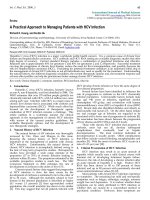Chapter 052. Approach to the Patient with a Skin Disorder (Part 6) pdf
Bạn đang xem bản rút gọn của tài liệu. Xem và tải ngay bản đầy đủ của tài liệu tại đây (106.51 KB, 5 trang )
Chapter 052. Approach to the Patient
with a Skin Disorder
(Part 6)
Dermatitis herpetiformis.
This disorder typically displays pruritic, grouped papulovesicles on elbows,
knees, buttocks, and posterior scalp. Vesicles are often excoriated due to
associated pruritus.
The shape of lesions is also an important feature. Flat, round, erythematous
papules and plaques are common in many cutaneous diseases. However, target-
shaped lesions that consist in part of erythematous plaques are specific for
erythema multiforme (Fig. 52-9).
In the same way, the arrangement of individual lesions is important.
Erythematous papules and vesicles can occur in many conditions, but their
arrangement in a specific linear array suggests an external etiology such as allergic
contact (Fig. 52-10) or primary irritant dermatitis. In contrast, lesions with a
generalized arrangement are common and suggest a systemic etiology.
Figure 52-9
Erythema multiforme.
This eruption is characterized by multiple erythematous plaques with a
target or iris morphology. It usually represents a hypersensitivity reaction to drugs
(e.g., sulfonylamides) or infections (e.g., HSV). (Courtesy of the Yale Resident's
Slide Collection; with permission.)
Figure 52-10









